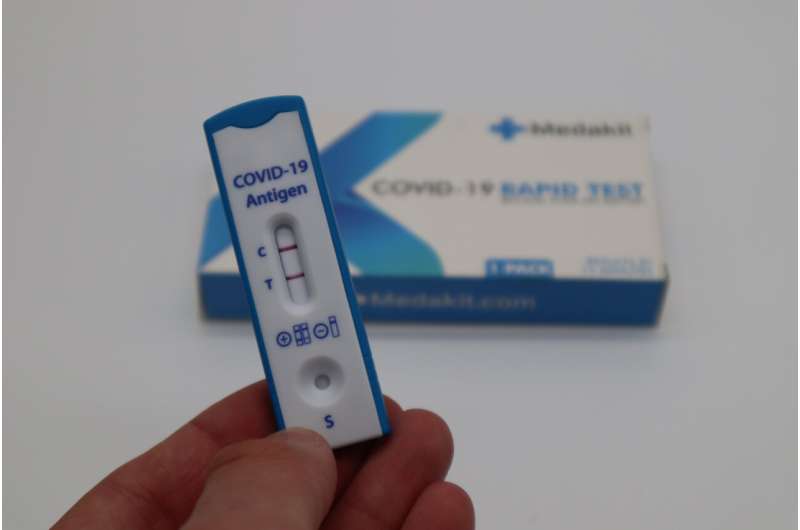
Lasting damage to the heart and brain is an aspect of long COVID that should receive much more attention than it has so far. We have sufficient evidence now to call for ongoing monitoring of individuals across the population.
At least one in ten people—and probably more—develop long COVID after the acute infection and many experience persistent debilitating symptoms, including fatigue, a disturbed sense of smell or taste, shortness of breath, brain fog, anxiety and depression.
But a much smaller group of people develops more life-threatening disorders, particularly cardiovascular disease, which includes heart attacks and strokes. The scale of this problem is now clearer.
We know that SARS-CoV-2, the virus that causes COVID, can directly infect heart tissue and cause microscopic blood clots, which can sometimes culminate in deep vein thrombosis, pulmonary embolism, myocardial infarction and stroke.
Several studies now show an elevated risk of cardiovascular outcomes following COVID and there may also be hidden pathology that will only emerge as people age.
We need to monitor people with a history of COVID, at least with regular check-ups by family practitioners. Even better, we should establish a registry to facilitate research and healthcare for people at risk.
Cardiovascular disease after the acute infection has passed
The first study to present large-scale data on long-term (rather than acute) cardiovascular complications from COVID was based on the national healthcare databases of the US Department of Veterans Affairs. It established a cohort of almost 154,000 individuals with COVID and two comparison groups, each of more that five million.
The research showed that, after 30 days, people with COVID were at increased risk of stroke (1.5-fold higher risk) and transient ischemic attacks of the brain (1.5-fold), abnormal heart rhythms (1.7-fold), ischemic heart disease (1.7-fold), pericarditis (inflammation of the outermost layer of the heart; 1.9-fold), myocarditis (inflammation of the heart muscle; 5.4-fold), heart failure (1.7-fold) and clotting disorders (2.4-fold).
These higher risks increased with the intensity of required care during the acute COVID phase but were evident even among those not hospitalized.
Another study focused on a younger group (mean age of 43 years), using data held by US healthcare organizations, with more than four million individuals who had completed a COVID test. Like the veterans study, follow-up began after 30 days and continued for 12 months.
The researchers compared rates of cardiovascular outcomes for groups with and without COVID infection. Those with COVID had a higher risk of stroke (1.6-fold) and transient ischemic attacks (1.5-fold), atrial fibrillation (2.4-fold), pericarditis (1.6-fold), myocarditis (4.4-fold), acute coronary artery disease (2.1-fold), heart attack (2-fold), heart failure (2.3-fold) and clotting disorders such as pulmonary embolism (2.6-fold).
The risk of a major adverse cardiovascular event was 1.9-fold higher. Risk for any cardiovascular outcome was about 1.6-fold higher, as was the risk of dying. These higher risks were seen among both men and women. The risk of dying was greater among people aged 65 and older.
Higher healthcare needs and excess deaths
The most recent study analyzed insurance claims from every US state to explore one-year outcomes in a group of more than 13,000 people with long COVID, compared with a matched group of more than 26,000 individuals without a history of COVID.
During follow-up, the long-COVID cohort sought higher healthcare for a wide range of adverse outcomes, including cardiac arrhythmias (2.4-fold higher), pulmonary embolism (3.6-fold), ischemic stroke (2.2-fold), coronary artery disease (1.8-fold), heart failure (2-fold) as well as emphysema and asthma.
The people with long COVID were more than twice as likely to die than the COVID-free controls.
It is notable these studies produced similar patterns of risk for cardiovascular disease. The risks of both myocarditis and clotting disorders were particularly elevated.
Another study took a different approach, estimating excess deaths due to cardiovascular disease across multiple pandemic waves in the US. From March 2020 to March 2022, there were more than 90,000 excess deaths from cardiovascular disease—4.9% more than expected.
What might we be missing?
These are all observational studies. There is always the concern that some unmeasured variables may explain the findings. However, the close consistency of these studies makes this less likely. The following two reports suggest that, if anything, these studies may be underestimating the size of the problem.
In a community-based UK prospective study of long COVID among low-risk individuals (low prevalence of comorbidities and only 19% hospitalized with acute COVID), 26% showed mild heart impairment four months after their initial diagnosis.
Cardiovascular MRI scans of 534 individuals with long COVID revealed one in five showed some cardiac impairment at six months, which persisted in more than half the group at 12 months. These two studies suggest sub-clinical cardiac disorder may be a much more common manifestation of long COVID than expected.
Does vaccination help?
One way to establish whether COVID infection is responsible for the higher rates of cardiovascular disease is to ask whether vaccination reduces risk (as it does with the more common symptoms of long COVID).
Two studies suggest vaccination approximately halves the risk of severe cardiovascular outcomes. A Korean study shows fully vaccinated people had less than half the risk of both heart attack and stroke compared to an unvaccinated group.
A similar study in the US—with groups categorized as fully vaccinated, partially vaccinated, and unvaccinated —observed most cardiovascular events in the unvaccinated group (12,733 of 14,000). Affected individuals had markedly more co-existing conditions, including previous major cardiovascular events, type 2 diabetes, high blood lipids, ischaemic heart disease, liver disease and obesity.
However, even taking these pre-existing higher risks into account, those who were fully vaccinated had a 41% lower risk. Partial vaccination conferred a 24% lower risk of severe cardiovascular disease.
The need to monitor people with a history of COVID, especially long COVID, is clear.
Provided by
The Conversation
This article is republished from The Conversation under a Creative Commons license. Read the original article.
Source: Read Full Article
